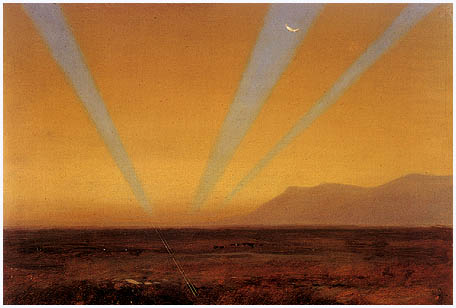
OPOD
What's New
Rays & Shadows
Crepuscular rays
Formation
Sky-wide rays
Lunar rays
Reflected rays
Reflected rays
More images
Mystery Painting
Anti-crepuscular
Cloud shadows
Mountain Shadow
Earth's Shadow Blue Sky
Sunsets
Sunset Mirages
Green Flash
Moonrise/set
Opposition effect
Water Droplets
Rainbows
Ice Halos
High Atmosphere
Links & Resources
Search - Index
123456789012345678

| Frederic Edwin Church Painting |
 Cooper-Hewitt, National Design Museum, Smithsonian Institution |
This small
oil sketch by the great American landscape painter Frederic Edwin
Church (1826 - 1900) clearly depicts crepuscular rays or cloud
shadows streaming upwards from a sun just below the horizon.
Amber-tan rays light the air. Where it is shadowed by clouds, blue
sky and a thin crescent moon are revealed. |
|
The painting was until recently thought
by art historians to be a study for his painting Aurora Borealis!
It is now claimed to be of a sunset near Church's home at
Olana in the Hudson Valley looking westwards with the Catskill Mountains
on the right.
|
the sunset point outside of the tropics in the Northern hemisphere. The rays cannot be anti-crepuscular because crescent moons do not appear opposite the sun. Church's portrayals of nature were usually so accurate that it is difficult to believe that he got it wrong. The sketch could be of a sunrise looking eastwards in the Hudson Valley, alternatively it could be a sunset seen by Church during his travels in Ecuador and Jamaica. |